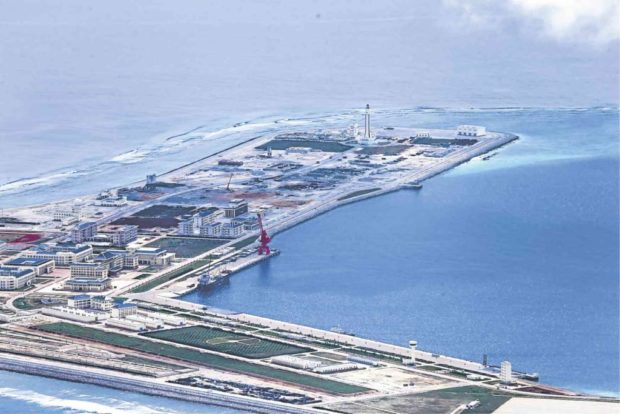Beijing permanently stations rescue ship in Spratlys

MILITARY OUTPOST This latest surveillance photo shows China’s military outpost on Zamora Reef is almost finished. CNBC has reported that China has deployed antishipmissiles and surface-to-air missile systems on Zamora and two other Philippine-claimed reefs.
China is stationing a search and rescue ship on its man-made island on Philippine-claimed Zamora Reef in the Spratly archipelago, in a “gray zone tactic” to assert its ownership of the disputed feature in the South China Sea.
In a report earlier this week, state-run China Daily said the Nanhai Rescue Bureau of the Ministry of Transport dispatched the ship Nan Hai Jiu 115 from Hainan, China’s southernmost island, to Zamora Reef on Friday.
The ship was expected to reach Zamora—internationally known as Subi Reef—on Monday, the report said.
No information
Malacañang had no comment on the China Daily report on Thursday.
Article continues after this advertisementPresidential spokesperson Harry Roque said he had no information about the rescue ship deployment to Zamora.
Article continues after this advertisementThe Department of Foreign Affairs also had no comment on the deployment.
Zamora is one of seven reefs claimed by the Philippines in the Spratlys that China has seized and developed into artificial islands to build military bases in the strategic South China Sea.
It is located 22 kilometers from Pagasa Island (Thitu), the largest of the nine features in the Spratlys occupied by the Philippines and the only one inhabited by civilians.
The other Philippine-claimed features that China has transformed into artificial islands and on which it has built military bases are Kagitingan (Fiery Cross), Calderon (Cuarteron), Burgos (Gaven), Mabini (Johnson South), Panganiban (Mischief) and McKennan (Hughes) reefs.
China claims nearly all of the 3.5-million-square-kilometer South China Sea, including waters close to the shores of its Southeast Asian neighbors the Philippines, Brunei, Malaysia and Vietnam, all of which have claims in the strategic waterway.
Arbitral ruling
Ruling on a challenge brought by the Philippines in 2013, the UN-backed Permanent Court of Arbitration in The Hague invalidated China’s sweeping claim in July 2016.
But the Duterte administration set aside the ruling in exchange for aid and investment from Beijing.
A separate report by the official Xinhua news agency said the Nan Hai Jiu would be “permanently stationed” on Zamora Reef.
It also marked the first time a Chinese civilian rescue force has settled in the Spratlys after its expansion.
According to the China Daily report, the search-and-rescue ship, described as China’s “most advanced” of its kind, is also capable of emergency medical services, firefighting and oil spill cleanup.
It has a heliport that can accommodate medium-sized rescue helicopters, the report said.
“China’s construction work on the Nansha (Spratlys) Islands and reefs aims not only to improve the lives of people stationed there and enhance their ability to cope with maritime security threats, but also to increase public services in the region,” the report quoted foreign ministry spokesperson Geng Shuang as saying.
‘Gray zone tactic’
“The deployment of a search and rescue ship is a gray zone tactic,” Jay Batongbacal, director of the University of the Philippines Institute for Maritime Affairs and Law of the Sea, told Inquirer.net.
In a report for the US Department of State last year, the International Security Advisory Board defined “gray zone” as “the use of techniques to achieve a nation’s goals and frustrate those of its rivals by employing instruments of power—often asymmetric and ambiguous in character—that are not direct use of acknowledged regular military forces.”
Batongbacal said the tactic allowed China to “permanently deploy assets in [the] Spratlys without appearing to be directly threatening, avoid protest and ostensibly as a public good.”
“At the same time, it provides an excuse for continuous surveillance and monitoring of all maritime activities that might require search and rescue,” he said, adding that the deployment would also be used “to demonstrate administration of the area as a regular part of its territory.”
Batongbacal warned that the deployment was a “pretext for a stronger presence so close to our largest island.”
“It could also be a probe, a precursor to similar deployments on [Panganiban] Reef. If we don’t object to such a deployment very close to Pagasa less than [28 km] away, then we shouldn’t object to stationing a similar vessel on [Panganiban] Reef [235 km] from Palawan,” he added.
PH territory
Panganiban Reef is within the Philippines’ 370-km exclusive economic zone in the South China Sea that China seized in 1995.
China insists that the facilities on its man-made islands in the Spratlys are primarily for civilian purposes, despite recent reports about its deployment of military planes and surface-to-air missiles on the islands.
Analysts say that the missile shelters, runways, ports, aircraft hangars on the islands make it clear that islands are military installations and definitely not for civilian use. —WITH REPORTS FROM CHRISTINE O. AVENDAÑO AND DONA Z. PAZZIBUGAN